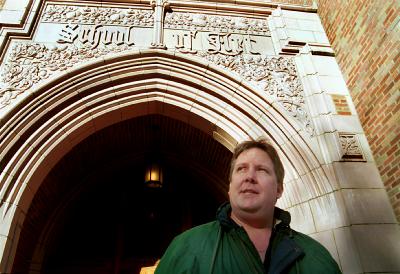December 5, 2002
High-tech upgrade to cut lighting bill in Art Building
There’s been no sighting of Big Brother or his infamous Thought Police just yet, but the UW’s Art Building will get an Orwellian face-lift during the upcoming winter break.
The building’s first floor will be equipped with occupancy sensor devices that can determine when a person enters or leaves a room. It’s the first phase of a pilot project that will, by the summer of 2003, wire the first three floors of the building in a similar fashion. But while technology in George Orwell’s novel 1984 was used by a totalitarian government to oppress the citizenry, it will be used at the UW to cut the energy bill.
“As soon as you walk into the room it will turn on the lights,” said Al Kruger, an electrical engineer for capital projects who came up with the plan. After leaving a room the lights will go out after about 15–20 minutes. That’s in contrast to manual light switches, many of which are turned on and left on for all hours of the day wasting precious natural resources and University money.
Kruger serves on the Conservation Project Development Team, a collection of people from across campus as well as an employee from Seattle City Light and one from Seattle Public Utilities. The group was formed in 2001 after Gov. Gary Locke directed state agencies to reduce energy consumption by 10 percent. The team continues to meet monthly and brainstorm projects to pursue that will reduce energy costs.
Committee members don’t get paid for their time and have to do the work on top of their other responsibilities. “We each have other full-time jobs,” said Dave Fields, who coordinates the committee.
They do it, he says, because it’s important work and it sends a message about conservation to the campus. That message, simply put, is that it pays to save. In fact, in just two years the team’s work has earned the UW almost $200,000 in incentive payoffs from Seattle Public Utilities plus an additional $264,000 in energy savings.
Some of their more successful projects include a cooling tower at the HUB, which saves water and about $100,000 annually for the University, and a lighting reduction program that has saved close to 600,000 watts by merely disconnecting unneeded light fixtures.
The Art Building project will rely on two types of devices — passive infrared sensors and ultrasonic detectors. The infrared sensors work by detecting body heat, then automatically turning on the lights. The ultrasonic detectors use sound waves. “They kind of act like a bat,” Kruger said. “They put out an ultrasonic signal and can detect its return. If the signal was disturbed by any kind of movement, it senses that and the lights come on.”
The sensors aren’t a new idea. In fact, Kruger says they’ve been used on campus previously, but with more failures than successes. This time, however, he is confident the project will work.
That confidence stems from two things. First, the company who sold the devices to the UW also helped with the installation and guaranteed success. Second, the technology that drives the occupancy sensor system has improved in recent years, he said. If he’s right, people on campus will be seeing more and more of the sensory devices.
“We’re excited about the project,” he said. “It’s about time we did something like this, I think. It will save the University a lot of money if this works out and we decide to do it wholesale across campus.”
And that’s exactly what he expects will happen.
“It doesn’t make sense nowadays not to do it.”
The total project cost for the Art Building pilot is estimated at about $85,000. The building will be equipped with 150 sensory devices, which run about $585 each. Seattle City Light will pay the UW $35 per installed device, bringing the cost down to about $550. And an incentive-based agreement with the city will give the UW even more money if the devices work to curb energy use. Combine those incentive payments with the fact that the system could slash a significant chunk from the UW’s energy bill, and it’s obvious why Kruger is so excited.
“We will actually realize quite a bit of energy savings, which just goes right into our pocket,” he said. “This project will likely pay for itself very quickly.”
And Fields says he’s confident there will be no encounters with the Thought Police.
“No. No images are being recorded or viewed by someone or something,” he said. “It’s technology and I guess you could say it’s progress. But I don’t view it as Big Brother.”
Savings in the works
A sampling of some of the other projects the Conservation Project Development Team is currently working on:
- Sterilizer Retrofits: Sterilizers used in Health Sciences and at the Medical Center can consume up to 2.5 gallons of water per minute. But the retrofitting project will substantially reduce that waste and generate savings of almost $170,000 annually.
- Balmer Water Conservation: Water-conserving fixtures, including 20 low-flush capacity toilets, have been installed. Data collection will continue through the end of the year to determine the level of conservation effectiveness.
- McMahon Kitchen Conversion: Will create a recycled water system that will save more than 4 million gallons of water annually. It will save the UW almost $40,000 annually plus there will be a rebate payment from Seattle Public Utilities.

